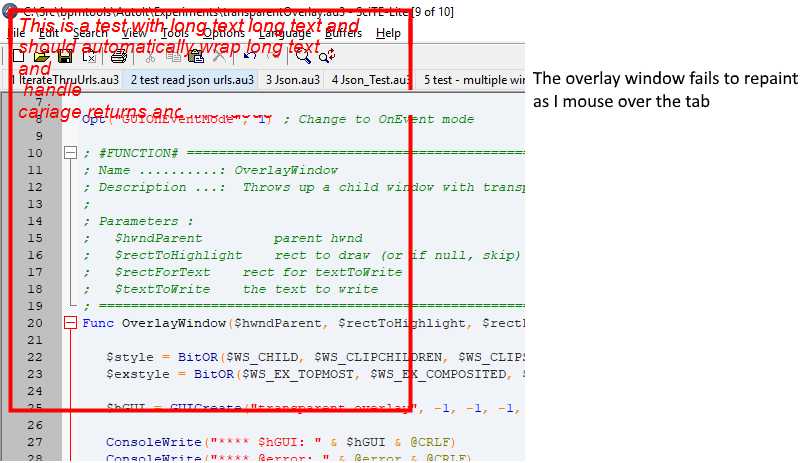Search the Community
Showing results for tags 'overlay'.
-
Hi there I am building a "statistics kiosk" where we will be enumerating through Web Pages, and Excel files, PDF reports and other applications each displaying statistics relevant to our project. I want to overlay some context over each page/screen so that viewers of this "statistics kiosk" have some info about that the data they are looking at is. I have written a function called OverlayWindow which is supposed to create a transparent window which displays some text. The function SEEMS to work BUT The handle returned from CreateGUI is 0 (despite there being NO error or extended information) The window is created but not maintained. In other words it appears but since it is not really maintained it is repainted as other content changes. The result is that the overlay appears BUT as soon as there is a reason for the underlying windows to repaint the overlay starts to "disappear" I have extracted the relevant code and created the most simplistic of samples here. #include <FileConstants.au3> #include <WinAPIFiles.au3> #include <GDIPlus.au3> #include <GUIConstantsEx.au3> #include <WindowsConstants.au3> #include <WinAPISysWin.au3> Opt("GUIOnEventMode", 1) ; Change to OnEvent mode ; #FUNCTION# ==================================================================================================================== ; Name ..........: OverlayWindow ; Description ...: Throws up a child window with transparent background over current window ; ; Parameters : ; $hwndParent parent hwnd ; $rectToHighlight rect to draw (or if null, skip) ; $rectForText rect for textToWrite ; $textToWrite the text to write ; =============================================================================================================================== Func OverlayWindow($hwndParent, $rectToHighlight, $rectForText, $textToWrite) $style = BitOR($WS_CHILD, $WS_CLIPCHILDREN, $WS_CLIPSIBLINGS) $exstyle = BitOR($WS_EX_TOPMOST, $WS_EX_COMPOSITED, $WS_EX_TRANSPARENT) $hGUI = GUICreate("transparent overlay", -1, -1, -1, -1, $style, $exstyle) ConsoleWrite("**** $hGUI: " & $hGUI & @CRLF) ConsoleWrite("**** @error: " & @error & @CRLF) ConsoleWrite("**** @extended: " & @extended & @CRLF) GUISetOnEvent($GUI_EVENT_CLOSE, "OverlayWindow_Exit") GUISetState(@SW_SHOW, $hGUI) $hGraphics = _GDIPlus_GraphicsCreateFromHWND($hGUI) ConsoleWrite("**** $hGraphics : " & $hGraphics & @CRLF) _GDIPlus_GraphicsSetSmoothingMode($hGraphics, $GDIP_SMOOTHINGMODE_HIGHQUALITY) $hPen = _GDIPlus_PenCreate(0xFFFF0000, 4) ; Red If ($rectToHighlight <> Null) Then _GDIPlus_GraphicsDrawRect($hGraphics, $rectToHighlight[0], $rectToHighlight[1], $rectToHighlight[2], $rectToHighlight[3], $hPen) EndIf _GDIPlus_PenDispose($hPen) $hBrush = _GDIPlus_BrushCreateSolid(0xFFFF0000) ; RED $hFormat = _GDIPlus_StringFormatCreate() $hFamily = _GDIPlus_FontFamilyCreate("Arial") $hFont = _GDIPlus_FontCreate($hFamily, 14, 2) $tLayout = _GDIPlus_RectFCreate($rectForText[0], $rectForText[1], $rectForText[2], $rectForText[3]) $aInfo = _GDIPlus_GraphicsMeasureString($hGraphics, $textToWrite, $hFont, $tLayout, $hFormat) _GDIPlus_GraphicsDrawStringEx($hGraphics, $textToWrite, $hFont, $aInfo[0], $hFormat, $hBrush) _GDIPlus_BrushDispose($hBrush) _GDIPlus_StringFormatDispose($hFormat) _GDIPlus_FontFamilyDispose($hFamily) _GDIPlus_FontDispose($hFont) _GDIPlus_GraphicsDispose($hGraphics) Return $hGUI EndFunc Func OverlayWindow_Exit() ConsoleWrite("* * * Exit event called" & @CRLF) EndFunc Func Handle_Esc() $Done = True EndFunc ;----------------------------------------------------------------- ;Main() _GDIPlus_Startup() Global $Done = False Local $rect = [10, 10, 400, 400] Local $rectForText = [15, 15, 380, 380] $hGUI = OverlayWindow(Null, $rect, $rectForText, "This is a test with long text long text and should automatically wrap long text " & @CRLF & "and " & @CRLF & " handle " & @CRLF & "cariage returns and line feeds") HotKeySet ( "{Esc}", Handle_Esc) While Not $Done Sleep(100) WEnd GUIDelete($hGUI) _GDIPlus_Shutdown () Exit 0 I am assuming the since CreateGUI returns 0 that the _GDIPlus_GraphicsCreateFromHWND is simply creating a "graphics context" based on the desktop then and not on my window. And thus - there IS no window (despite no @error nor no @extended data) So I think the issue is in the "styles" of window I am using. If I don't use WS_CHILD (for example I use WS_POPUP) then I get a handle back for my window and the lifetime of the window is what i want but it is not transparent as I want. Setting styles on the window to be transparent (either using extended styles, or using WinSetTrans or _WinAPI_SetBkMode) results in my rectangle and string being transparent - not what I want either. Any suggestions? any and all help is appreciated Thanks!
- 4 replies
-
- guicreate
- ws_ex_transparent
-
(and 1 more)
Tagged with:
-
Hello ppl, i've been playing with overlays but im having problems with keeping my window over some games, the objective is to display a bit of text with information about volume, when i change it, some applications have overlays that work well, like mumble, but mumble is permanent, and im looking for something that only shows at will. Having $WS_EX_TOPMOST as a parameter doesn't make any difference, along with WinSetOnTop, running out of ideas. BTW: This isn't considered interaction, is it? Best regards.
-
PE File Overlay Extraction (and Certificate info) Executable and other PE files can contain "overlays", which is data that is appended to the end of the file. This data can be important, such as setup packages, Authenticode signatures*, and overlays for AutoIt scripts. Or it could just be extra unneeded cruft (sometimes). Whatever the case is, I wanted to find a way to detect if this data was present. This project is actually a result of dealing with so-called 'File Optimizer' programs that would strip Overlay information from Executables (leaving compiled AutoIt scripts crippled!). And also a legit >answer to my topic in Help and Support. While future versions of AutoIt (new beta releases and any official release after v3.3.8.1) are putting tokenized scripts into a resource within the executable, all current compiled scripts are still put together with the tokenized script appended as an overlay. The UDF here allows you to detect any overlay a PE (Portable Executable) file may have, and allows you to extract the Overlay into a separate file - or alternatively extract the exe without the overlay. You can actually extract AutoIt scripts and write them to .A3X files using this method, if you so desire. But don't be a hacker! Mommy will scold you.. If you separate both the exe and overlay, you can combine them again using a simple file-append, something like: copy /b stripped.exe+script.a3x myscript.exe _ Anyway, the method to detect overlays is relatively simple - we need to look through the PE file's various headers and find out where the last section of data/code is and its size. If that last section doesn't reach the end of the file, then you will find an Overlay waiting at the end of the final section. However, there's an issue with Certificate Tables (or signatures) which makes it a bit more tricky to detect - basically the end of the last section and the beginning of the Certificate must be examined to find the sandwiched-in overlay. *Auhenticode signatures note: These and other certificates are actually linked to in the PE Data Directory, which I had missed in earlier versions. Now they are accounted for however, and not considered overlays nor are they allowed to be extracted (well, you could extract them but the signature is bound to the unique checksum of the file and needs to be referenced from the Data Directory). IMPORTANT: The example now queries which part to save, and "No" button means 'yes' to Exe extract. (I didn't want to mess around with creating dialog windows, sorry). So, here's the UDF with a working example (note the 128MB limit can easily be worked around): ; ======================================================================================================== ; <FilePEOverlayExtract.au3> ; ; UDF and Example of getting Overlay info and optionally extracting that info to a file. ; ; NOTE that this isn't intended to be used to hack or decompile AutoIt executables!! ; It's main purpose is to find Overlays and Certificates and extract/save or just report the info ; ; Functions: ; _PEFileGetOverlayInfo() ; Returns a file offset for overlay data (if found), and the size ; ; Author: Ascend4nt ; ======================================================================================================== ; Arry indexing Global Enum $PEI_OVL_START = 0, $PEI_OVL_SIZE, $PEI_CERT_START, $PEI_CERT_SIZE, $PEI_FILE_SIZE ; ---------------------- MAIN CODE ------------------------------- Local $sFile, $sLastDir, $sLastFile, $aOverlayInfo $sLastDir = @ScriptDir While 1 $sFile=FileOpenDialog("Select PE File To Find Overlay Data In",$sLastDir,"PE Files (*.exe;*.dll;*.drv;*.scr;*.cpl;*.sys;*.ocx;*.tlb;*.olb)|All Files (*.*)",3,$sLastFile) If @error Or $sFile="" Then Exit $sLastFile=StringMid($sFile,StringInStr($sFile,'\',1,-1)+1) $sLastDir=StringLeft($sFile,StringInStr($sFile,'\',1,-1)-1) $aOverlayInfo = _PEFileGetOverlayInfo($sFile) If $aOverlayInfo[$PEI_OVL_START] = 0 Then ConsoleWrite("Failed Return from _PEGetOverlayOffset(), @error = " & @error & ", @extended = " & @extended & @CRLF) MsgBox(64, "No Overlay Found", "No overlay found in " & $sLastFile) ContinueLoop EndIf ConsoleWrite("Return from _PEFileGetOverlayInfo() = " & $aOverlayInfo[$PEI_OVL_START] & ", @extended = " & $aOverlayInfo[$PEI_OVL_SIZE] & @CRLF) If $aOverlayInfo[$PEI_OVL_START] Then Local $hFileIn = -1, $hFileOut = -1, $sOutFile, $iMsgBox, $bBuffer, $bSuccess = 0 $iMsgBox = MsgBox(35, "Overlay found in " & $sLastFile, "Overlay Found. File size: " & $aOverlayInfo[$PEI_FILE_SIZE] & ", Overlay size: " & $aOverlayInfo[$PEI_OVL_SIZE] & @CRLF & @CRLF & _ "Would you like to:" & @CRLF & _ "[Yes]: extract and save Overlay" & @CRLF & _ "[No]: extract Exe without Overlay" & @CRLF & _ "[Cancel]: Do Nothing") If $iMsgBox = 6 Then If $aOverlayInfo[$PEI_OVL_SIZE] > 134217728 Then MsgBox(48, "Overlay is too huge", "Overlay is > 128MB, skipping..") ContinueLoop EndIf $sOutFile = FileSaveDialog("Overlay - SAVE: Choose a file to write Overlay data to (from " & $sLastFile&")", $sLastDir, "All (*.*)", 2 + 16) If Not @error Then While 1 $hFileOut = FileOpen($sOutFile, 16 + 2) If $hFileOut = -1 Then ExitLoop $hFileIn = FileOpen($sFile, 16) If $hFileIn = -1 Then ExitLoop If Not FileSetPos($hFileIn, $aOverlayInfo[$PEI_OVL_START], 0) Then ExitLoop ; AutoIt 2/3 Signature check requires 32 bytes min. If $aOverlayInfo[$PEI_FILE_SIZE] > 32 Then $bBuffer = FileRead($hFileIn, 32) If @error Then ExitLoop ; AutoIt2 & AutoIt3 signatures If BinaryMid($bBuffer, 1, 16) = "0xA3484BBE986C4AA9994C530A86D6487D" Or _ BinaryMid($bBuffer, 1 + 16, 4) = "0x41553321" Then ; "AU3!" ConsoleWrite("AutoIt overlay file found" & @CRLF) EndIf FileWrite($hFileOut, $bBuffer) ; subtract amount we read in above $bSuccess = FileWrite($hFileOut, FileRead($hFileIn, $aOverlayInfo[$PEI_OVL_SIZE] - 32)) Else $bSuccess = FileWrite($hFileOut, FileRead($hFileIn, $aOverlayInfo[$PEI_OVL_SIZE])) EndIf ExitLoop WEnd If $hFileOut <> -1 Then FileClose($hFileOut) If $hFileIn <> -1 Then FileClose($hFileIn) EndIf ElseIf $iMsgBox = 7 Then If $aOverlayInfo[$PEI_FILE_SIZE] - $aOverlayInfo[$PEI_OVL_SIZE] > 134217728 Then MsgBox(48, "EXE is too huge", "EXE (minus overlay) is > 128MB, skipping..") ContinueLoop EndIf $sOutFile = FileSaveDialog("EXE {STRIPPED} - SAVE: Choose a file to write EXE (minus Overlay) to. (from " & $sLastFile&")", $sLastDir, "All (*.*)", 2 + 16) If Not @error Then $bSuccess = FileWrite($sOutFile, FileRead($sFile, $aOverlayInfo[$PEI_OVL_START])) EndIf Else ContinueLoop EndIf If $bSuccess Then ShellExecute(StringLeft($sOutFile,StringInStr($sOutFile,'\',1,-1)-1)) Else MsgBox(64, "Error Opening or writing to file", "Error opening, reading or writing overlay info") EndIf EndIf WEnd Exit ; ------------------------ UDF Function ---------------------------- ; =================================================================================================================== ; Func _PEFileGetOverlayInfo($sPEFile) ; ; Returns information on Overlays present in a Windows PE file (.EXE, .DLL etc files), as well as Certificate Info. ; ; Only certain executables contain Overlays, and these are always located after the last PE Section, ; and most times before any Certificate info. Setup/install programs typically package their data in Overlays, ; and AutoIt compiled executables (at least up to v3.3.8.1) contain an overlay in .A3X tokenized format. ; ; Certificate info is available with or without an overlay, and comes after the last section and typically after ; an Overlay. Certificates are included with signed executables (such as Authenticode-signed) ; ; The returned info can be used to examine or extract the Overlay or Certificate, or just to examine the data ; (for example, to see if its an AutoIt tokenized script). ; ; NOTE: Any Overlays packaged into Certificate blocks are ignored, and the methods to extract this info may ; fail if the Certificate Table entries have their sizes modified to include the embedded Overlay. ; ; The returned information can be useful in preventing executable 'optimizers' from stripping the Overlay info, ; which was the primary intent in creating this UDF. ; ; ; Returns: ; Success: A 5-element array, @error = 0 ; [0] = Overlay Start (if any) ; [1] = Overlay Size ; [2] = Certificate Start (if any) ; [3] = Certificate Size ; [4] = File Size ; ; Failure: Same 5-element array as above (with all 0's), and @error set: ; @error = -1 = Could not open file ; @error = -2 = FileRead error (most likely an invalid PE file). @extended = FileRead() @error ; @error = -3 = FileSetPos error (most likely an invalid PE file) ; @error = 1 = File does not exist ; @error = 2 = 'MZ' signature could not be found (not a PE file) ; @error = 3 = 'PE' signature could not be found (not a PE file) ; @error = 4 = 'Magic' number not recognized (not PE32, PE32+, could be 'ROM (0x107), or unk.) @extended=number ; ; Author: Ascend4nt ; =================================================================================================================== Func _PEFileGetOverlayInfo($sPEFile) ;~ If Not FileExists($sPEFile) Then Return SetError(1,0,0) Local $hFile, $nFileSize, $bBuffer, $iOffset, $iErr, $iExit, $aRet[5] = [0, 0, 0, 0] Local $nTemp, $nSections, $nDataDirectories, $nLastSectionOffset, $nLastSectionSz Local $iSucces=0, $iCertificateAddress = 0, $nCertificateSz = 0, $stEndian = DllStructCreate("int") $nFileSize = FileGetSize($sPEFile) $hFile = FileOpen($sPEFile, 16) If $hFile = -1 Then Return SetError(-1,0,$aRet) ; A once-only loop helps where "goto's" would be helpful Do ; We keep different exit codes for different operations in case of failure (easier to track down what failed) ; The function can be altered to remove these assignments of course $iExit = -2 $bBuffer = FileRead($hFile, 2) If @error Then ExitLoop $iExit = 2 ;~ 'MZ' in hex (endian-swapped): If $bBuffer <> 0x5A4D Then ExitLoop ;ConsoleWrite("MZ Signature found:"&BinaryToString($bBuffer)&@CRLF) $iExit = -3 ;~ Move to Windows PE Signature Offset location If Not FileSetPos($hFile, 0x3C, 0) Then ExitLoop $iExit = -2 $bBuffer = FileRead($hFile, 4) If @error Then ExitLoop $iOffset = Number($bBuffer) ; Though the data is in little-endian, because its a binary variant, the conversion works ;ConsoleWrite("Offset to Windows PE Header="&$iOffset&@CRLF) $iExit = -3 ;~ Move to Windows PE Header Offset If Not FileSetPos($hFile, $iOffset, 0) Then ExitLoop $iExit = -2 ;~ Read in IMAGE_FILE_HEADER + Magic Number $bBuffer = FileRead($hFile, 26) If @error Then ExitLoop $iExit = 3 ; "PE/0/0" in hex (endian swapped) If BinaryMid($bBuffer, 1, 4) <> 0x00004550 Then ExitLoop ; Get NumberOfSections (need to use endian conversion) DllStructSetData($stEndian, 1, BinaryMid($bBuffer, 6 + 1, 2)) $nSections = DllStructGetData($stEndian, 1) ; Sanity check If $nSections * 40 > $nFileSize Then ExitLoop ;~ ConsoleWrite("# of Sections: " & $nSections & @CRLF) $bBuffer = BinaryMid($bBuffer, 24 + 1, 2) ; Magic Number check (0x10B = PE32, 0x107 = ROM image, 0x20B = PE32+ (x64) If $bBuffer = 0x10B Then ; Adjust offset to where "NumberOfRvaAndSizes" is on PE32 (offset from IMAGE_FILE_HEADER) $iOffset += 116 ElseIf $bBuffer = 0x20B Then ; Adjust offset to where "NumberOfRvaAndSizes" is on PE32+ (offset from IMAGE_FILE_HEADER) $iOffset += 132 Else $iExit = 4 SetError(Number($bBuffer)) ; Set the error (picked up below and set in @extended) to the unrecognized Number found ExitLoop EndIf ;~ 'Optional' Header Windows-Specific fields $iExit = -3 ;~ -> Move to "NumberOfRvaAndSizes" at the end of IMAGE_OPTIONAL_HEADER If Not FileSetPos($hFile, $iOffset, 0) Then ExitLoop $iExit = -2 ;~ Read in NumberOfRvaAndSizes $nDataDirectories = Number(FileRead($hFile, 4)) ; Sanity and error check If $nDataDirectories <= 0 Or $nDataDirectories > 16 Then ExitLoop ;~ ConsoleWrite("# of IMAGE_DATA_DIRECTORY's: " & $nDataDirectories & @CRLF) ;~ Read in IMAGE_DATA_DIRECTORY's (also moves file position to IMAGE_SECTION_HEADER) $bBuffer = FileRead($hFile, $nDataDirectories * 8) If @error Then ExitLoop ;~ IMAGE_DIRECTORY_ENTRY_SECURITY entry is special - it's "VirtualAddress" is actually a file offset If $nDataDirectories >= 5 Then DllStructSetData($stEndian, 1, BinaryMid($bBuffer, 4 * 8 + 1, 4)) $iCertificateAddress = DllStructGetData($stEndian, 1) DllStructSetData($stEndian, 1, BinaryMid($bBuffer, 4 * 8 + 4 + 1, 4)) $nCertificateSz = DllStructGetData($stEndian, 1) If $iCertificateAddress Then ConsoleWrite("Certificate Table address found, offset = " & $iCertificateAddress & ", size = " & $nCertificateSz & @CRLF) EndIf ; Read in ALL sections $bBuffer = FileRead($hFile, $nSections * 40) If @error Then ExitLoop ;~ DONE Reading File info.. ; Now to traverse the sections.. ; $iOffset Now refers to the location within the binary data $iOffset = 1 $nLastSectionOffset = 0 $nLastSectionSz = 0 For $i = 1 To $nSections ; Within IMAGE_SECTION_HEADER: RawDataPtr = offset 20, SizeOfRawData = offset 16 DllStructSetData($stEndian, 1, BinaryMid($bBuffer, $iOffset + 20, 4)) $nTemp = DllStructGetData($stEndian, 1) ;ConsoleWrite("RawDataPtr, iteration #"&$i&" = " & $nTemp & @CRLF) ; Is it further than last section offset? ; AND - check here for rare situation where section Offset may be outside Filesize bounds If $nTemp > $nLastSectionOffset And $nTemp < $nFileSize Then $nLastSectionOffset = $nTemp DllStructSetData($stEndian, 1, BinaryMid($bBuffer, $iOffset + 16, 4)) $nLastSectionSz = DllStructGetData($stEndian, 1) EndIf ; Next IMAGE_SECTION_HEADER $iOffset += 40 Next ;~ ConsoleWrite("$nLastSectionOffset = " & $nLastSectionOffset & ", $nLastSectionSz = " & $nLastSectionSz & @CRLF) $iSucces = 1 ; Everything was read in correctly Until 1 $iErr = @error FileClose($hFile) ; No Success? If Not $iSucces Then Return SetError($iExit, $iErr, $aRet) ;~ Now to calculate the last section offset and size to get the 'real' Executable end-of-file ; [0] = Overlay Start $aRet[0] = $nLastSectionOffset + $nLastSectionSz ; Less than FileSize means there's Overlay info If $aRet[0] And $aRet[0] < $nFileSize Then ; Certificate start after last section? It should If $iCertificateAddress >= $aRet[0] Then ; Get size of overlay IF Certificate doesn't start right after last section ; 'squeezed-in overlay' $aRet[1] = $iCertificateAddress - $aRet[0] Else ; No certificate, or < last section - overlay will be end of last section -> end of file $aRet[1] = $nFileSize - $aRet[0] EndIf ; Size of Overlay = 0 ? Reset overlay start to 0 If Not $aRet[1] Then $aRet[0] = 0 EndIf $aRet[2] = $iCertificateAddress $aRet[3] = $nCertificateSz $aRet[4] = $nFileSize Return $aRet EndFunc FilePEOverlayExtract.au3 ~prev downloads: 34 Updates: 2013-08-09-rev2: Fixed: Didn't detect 'sandwiched-in' Overlays - Overlays appearing between the end of code/data and before a Certificate section Changed: UDF now returns an array of information: Overlay offset and size, Certificate offset and size, and filesize Fixed: Overlays < 32 bytes may have been written incorrectly 2013-08-09: Fix: Certificate Table now identified and excluded from false detection as Overlay. 2013-08-07: Fix: Section Offsets that start beyond the filesize are now accounted for. I'm not sure when this happens, but it's been reported to happen on other sites. Modified: A more reasonable filesize limit. Modified: Option to Extract just the Executable without Overlay, or the Overlay itself 2013-08-03: Fixed: Calculation of FileRead data was off by 16 (which still worked okay, but was not coded correctly!) Fixed: @extended checking after calls to other code
- 21 replies




